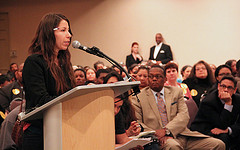In the song El Lavaplatos it says, “Toss some gravel and sand in the cement mixer. Fifty cents an hour until the whistle blows. Four or more of us strained at the famous pulley. And I, how could I stand it, I was better off washing dishes. How repentant, how repentant, for having come.” This song details the struggles many Mexican workers had to face in the United States. Under these obscene conditions a few brave workers made the decision to sow seeds of a movement. The Strategic Action for a Just Economy (SAJE) was established in 1996 to exhort community integrity, economic democracy for all, and tenants rights. Since its founding SAJE has created the country’s first welfare-to-work account, established a community land trust, and has challenged real estate developers to partner with the local community to boost job creation.
In the Latino Social Movements course the question about the function of movements was posed, and the theories of social change were presented. In the book L.A. Story: Immigrant Workers and the Future of the U.S. Labor Movement by Ruth Milkman it says, “The city was notorious as a “company town” where employers were intransigently opposed to organized labor.” Comparable to the text, SAJE is determined to create concrete economic benefits to working people, strengthen their economic rights, and has built a movement encompassing organized labor. Milkman revealed the racially and economically prejudiced history of labor in Los Angeles. SAJE spotlights the pursuit of economic democracy while shunning socioeconomic injustice.
SAJE uses public demonstrations or political rallies, and direct action to battle identity and racial formation in South Los Angeles. In the book Racial Formation in the Twenty-First Century by Tomás Almaguer racialization is defined as, “The extension or elaboration of racial meaning to particular relationships, social practices, or groups.” For many years the people of South Los Angeles have been racialized and predisposed to unjust labor practices. SAJE combats unemployment and health disparity because racialization plays a critical role in these issues. Latinos (immigrant populace included) and African Americans have higher unemployment rates compared to whites. In addition, these groups of peoples are exposed to a plethora of fast food options in their communities and are obese at higher rates compared to whites.
In August 2013 the Los Angeles unemployment rate was 8.9% excluding the number of people who have stopped actively seeking employment and the incarcerated populations. In South Los Angeles 30% of adults are uninsured and 37% of households are overcrowded. Racialization has played a role in the social and economic practices for residents of South Los Angeles. SAJE has actualized the Figueroa Corridor Community Jobs Program to battle unemployment and is the co-convener of the South Los Angeles Health and Human Rights Conference.
SAJE has continued to reinvent its strategies to announce their shared narrative. The narrative is “Development Yes! Displacement No!” Their scale is local, and their demographic target is predominantly Latino (immigrant population included) and African-American. Examples of SAJE’s effectiveness are action plans from the University of Southern California and the City of Los Angeles planners. They are gearing up their resources to confront racialization, and prepare the next generation of community leaders.
I strongly believe that social organizations like this are integral to fixing both health disparity and unemployment in South Los Angeles. If the people are informed of their rights then chances are they’ll make increased informed decisions. This social organization’s mission and actions pertain to the Latino Social Movements course because it displays how Latinos have historically used grassroots community organizing to bring sociopolitical change to contest racial and social inequality, and claim their citizenship in the United States.
The stakeholder groups are:
-SAJE Board of Directors
-Donors
-Community Leaders
The key actors are:
- Foundations – increasing brand exposure, and limiting the opposition of SAJE community supporters. (Interests)
- Constituents – real economic surplus and the beginning to an end of health disparity. (Interests)
References:
1. Milkman, Ruth. 2006. L.A. Story: Immigrant Workers and the Future of the U.S. Labor
Movement. New York: Russell Sage Foundation.
2. Tomás Almaguer. 2012. “Race, Racialization, and Latino Populations in the United States.” In
Racial Formation in the Twenty-First Century, 143–161. Berkeley, CA: University of California Press.
3. El Lavaplatos Recording











